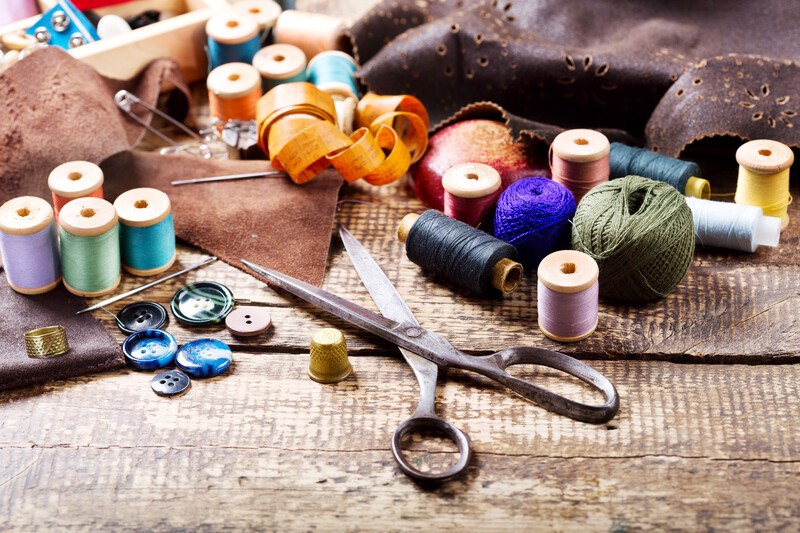
>>Build An Income-Generating Website That Lasts Decades!<<
—>>Watch how I built my business step-by-step in a few minutes.
—>>Earn online income for a lifetime.
>>Start Now<<
If you have a passion for arts and crafts, starting your own craft blog makes so much sense. A blog can be a powerful way to showcase your creations. Of course, to do this, you need to actually build a website, which includes brainstorming some decent craft blog name ideas.
That’s where this post comes in. In it, I highlight 50 different craft blog names that you can turn to for inspiration, along with some practical tips for choosing the best name possible.
I also let you in on a fact that many people miss – that the name of your site doesn’t actually matter. Sure, the site name is often the first thing that people notice and it can influence first impressions, but the effects are minor.
The real power of your site is what you put on it. Your content, your voice and the areas that you focus on all end up having a much more significant impact on your site’s success.
As such, this post goes beyond just offering a list of ideas for your blog name. I also talk about other critical areas, including where you can buy your domain name from and how you can make money from your site. These areas are important to understand early on, especially as they could influence what angles you end up taking with your site.
- 50 Craft Blog Name Ideas
- How To Choose A Good Blog Name
- Keyword VS Branding
- How To Buy A Domain Name
- How To Build & Make Money From Your Craft Website
- How Much Do Craft Bloggers Make?
- Display Ads
- Affiliate Links
- Final Thoughts
- Should You Start Your Own Blog?
- How To Choose A Good Blog Name
50 Craft Blog Name Ideas
- Paradise Crafter
- A Resourceful Soul
- We Create Wonder
- Crafting Cute
- Create the Wonders
- Dreaming of Crafts
- Cool Family Crafts
- The Crafter Group
- Crafts of Home
- Crafted from Faith
- Crafty Single Mom
- Making and Creating
- Parade of Crafts
- Crafts in Faith
- Arts and Wood Crafts
- Christian Craft Space
- Creations in Life
- Crafters of Spirit
- Absent Artisans
- Craft Away Today
- Crafts from Faith
- Great Old Crafts
- Crafty Domestic
- Craft Here with Me
- The Crafting Mom Reviews
- Modern Family Crafts
- Made with Kids
- Crafts and Me
- Crafting Beginner
- Crafts and Castles
- Crafty Tricks for You
- Miniature Crafting
- The Crafting Dad
- Christian Made Crafting
- Hands of Old
- Becoming a Crafter
- The Crafty Guys
- Our Heart Crafts
- Evermore Creating
- The Crafty Things
- Crafts of Old
- Miniature Craft Studio
- Crafty Creative Network
- Christian Craft Project
- Dreams of Crafts
- Miniature Hand Crafts
- Family Handicrafts
- Easy Crafty Tricks
- Creative Christian Crafts
- The Crafty Crowd

You might notice one interesting pattern with these blog names – none of them are one-of-a-kind. At the end of the day, they’re just names. Some of them might be fun to use, but your voice is still what will determine the success of your site.
How To Choose A Good Blog Name
When it comes to choosing a blog name, there are a few key tricks that can help. These reduce the risk of any serious problems further down the line.
The first area relates to branding and copyright. You want to be sure that the name you want isn’t taken by someone else. For example, Hobby Lobby wouldn’t work as a craft blog name. Anything too close to that might be problematic too.
I always do a few searches on any potential blog name, just so that I know what comes up. After all, it’s always going to be more difficult to rank for a particular name if that phrase is used elsewhere.
Another area is how logical the blog name is. Imagine that someone is talking about your blog on a radio show. You’d like them to be able to say the name once and then people could easily find your site. It’s best to avoid situations like my site where you have to be very specific about the domain name. Jamil’s Hobby Korner is a good example. Someone might not know how to spell Jamil, and explaining that it’s “Corner with a K” will get old fast.
Avoiding numbers and dashes in the domain name is a good general rule that can help a lot, plus you can also focus on names that are memorable and short. This makes it easier to find your site too.
One final thing to consider is the domain extension. The most common, by far, is .com. A .com site tends to rank the best and it inspires trust too. If it’s too hard to find what you want as a .com, you might consider another well-known option, like .org, .net or a regionally-specific domain extension.
Even then, I recommend caution. Avoid the more obscure extensions, like .blog or .xyz. These rarely rank well and are hard to remember. Though Crafts.fun is probably available, you might struggle to rank something like in the same speed as a .com would perform.
Keyword VS Branding
When you’re thinking about a blog name, two general strategies can be helpful. The first is to focus on a keyword. Using keywords is always useful for getting search engine traffic to your site. Keyword research isn’t as technical as it sounds and it is something that even beginners can get involved with.
The keyword angle can help you to find website names, as you have a starting point to work with. You could easily plug the keyword into various domain name generators and see what they spit out. These are called EMDs (Exact Match Domains).
While EMDs have their benefits, they can be frustrating too. One problem is that other blogs in your field are likely to use similar keywords. This can lead to websites that all kind of sound the same, which is something that you don’t want. As a consumer, can you really differentiate between bestcraftsonline.com vs bestcraftsonline.net vs thebestcraftsonline.com?
Finding an unusual or unique keyword-based website name is possible, but it takes more time and effort. This brings us to the second strategy – branding.
A branded name doesn’t rely on a keyword. Some even use made-up words, while others may use a word that isn’t related to their field at all.
The idea is that you can create something that is easy to remember and stands out. Branded names can be easier to promote on social media, as your website name is often short and snappy. “Clouds In The Sky” could be a personal finance blog, a craft blog, or a foodie blog. Who knows?
There often won’t be a logical link between your website name and topic. This can be confusing for visitors at first, but the issue tends to dissipate as your site gets more well-known.
How To Buy A Domain Name
Website domains can be purchased through domain name registrars. You pay a yearly fee to have exclusive use of the domain name. Because you never actually own the domain per se, keeping up with that yearly fee is important (otherwise someone else could manage to acquire your domain name).
Domain name companies tend to have the same general services. The ‘quality’ of the domain name is the same either way, so most domain registrars will be perfectly fine for your needs.
Even so, some companies are easier to use than others and give you more for your money. My current favorite is Namecheap. I like the way that this service keeps their pricing structure clear and avoids any hidden fees. The company also provides more services for their base price than most other companies.
Namecheap supports most domain name types too. The main limitation that I’ve noticed is that some regional top level domains are excluded, like .co.nz. Still, .com ends up being a better choice in most cases, so the exclusion isn’t a large problem.
How To Build & Make Money From Your Craft Website
Here’s the big topic – making money. Earning online provides you with income that is completely separate from the traditional 9-to-5 drag. Some people earn full-time income online, while others use their site to make a little extra on the side.
There are countless ways to earn from a website. As a crafter, you might even get to the point of making and selling your own products by installing an ecommerce plugin. Many people do. Your website could be used to directly sell those products or to promote them.
Still, this post is focused on beginners, so we’re going to talk about methods that you can use right from the beginning. The most common techniques are display ads and affiliate marketing.
Some people choose one of these two styles, while others use both. As your confidence and traffic increases, you can expand the ways that you earn from your website. Even if you don’t plan to make money immediately, it’s important to think about this topic before you set your website up.

Before you get started, there’s just one thing I highly recommend – use WordPress. Sites like Wix, Squarespace, and Weebly are gaining popularity, and starting to advertise on my favorite podcasts. Those sites are mostly meant for personal brands and companies. Stuff like local restaurants, or a farmers market stall. For affiliate marketing, WordPress is where it’s at.
Some folks shy away from WordPress because it has a slightly steeper learning curve, but long term, it’s worth spending a few more weeks learning it so you can grow your website to its full potential in the coming years.
How Much Do Craft Bloggers Make?
The best way to see how much potential craft blogging has is to take a look at some of the successes in the field. One of these is Jackie from I Heart Arts n Crafts.
Her December 2015 income report showcased profits of $4,045.70 for the month. More than $2,000 of that income came from display ads. Some of Jackie’s posts were highly popular on Pinterest and Facebook, providing a traffic boost to the site.
Jackie also earned around $1,800 from sponsored posts. While she has affiliate marketing links in place too, these did not generate a large amount of profit for that particular month.
A second success story is Jennifer from Jennifer Maker. Her site specializes in crafts of all different types. She highlights a variety of income reports across the history of her site. While the details provided are limited, she states that her income increased from $33 per month to around $15,000, which is pretty stunning.
Display Ads
Display ads are probably the most popular way to make money through a blog. Their biggest appeal is that they’re simple to install and start earning. You can get away with setting up the ads on your site once and letting the system work on its own.
With display ads, you get paid a little bit by hosting ads on your site. The amount per ad is very low, to the point that it can seem a little absurd at times.
In fact, I was once very harsh on display ads. I used to think that the amount of traffic you need for success was just too high. You do need a lot of traffic, that’s true, but the amount of people that use the internet each day is insane. Getting enough traffic isn’t an impossible goal.
The reliance on traffic does mean that you won’t earn much from ads when you first begin. Building up to a decent income takes time and a lot of patience. Once your traffic is there though, you can earn a lot of money, and it will all seem “passive”, now that the previous work you did is finally paying off.
Ads are an important income strategy for many webmasters! I think it’s an especially good way to monetize a craft blog because craft items are often inexpensive, meaning your affiliate commissions might not be as attractive as compared to a fitness blog, which may be promoting $15,000 Bowflex machines (I have no idea how much a Bowflex costs).
Affiliate Links
Affiliate marketing is the other main approach to consider for earning money with your craft blog. This is a more active way of making money, where you are placing affiliate links within your content.
These links direct users to products or services that they can purchase. You earn a commission from any sales that are made, while the price for the customer remains unchanged. Amazon has the most famous affiliate program in the world, paying out hundreds of millions of dollars per year.
Affiliate marketing is a powerful way to earn, since you can promote countless different types of products. This means that affiliate marketing can work for almost any niche that you can think of.
Using affiliate marketing doesn’t mean that you have to rely heavily on sales pitches either. Some sites do, while others simply highlight products that they are already using themselves.
For example, on a craft blog, you could create a how-to post that links to various items that you use in your crafting. You need supplies for knitting, candle making, and woodworking. You might also write reviews on particular products that you enjoy and why you recommend them.
When done well, affiliate marketing doesn’t feel intrusive. You’re providing visitors with recommendations and information that they are interested in, without trying to con them into a sale.
Building an affiliate website isn’t difficult either. The process can seem more complicated than display ads, but you also have much more control over the process. This means that you can choose which affiliate programs you sign up for and how you promote the products.
Final Thoughts
Creating your own craft website isn’t nearly as complicated as it first sounds. Sure, there are plenty of decisions to make, including the name of your blog, the domain registrar, where the site is hosted and how you make money, but none of these are as critical as they sound (with the exception of hosting)
Most decisions can be changed later and those that can’t don’t tend to have long-term negative impacts. This is especially true for the name of your site. Even if you break all the ‘rules’ and end up with an unappealing site name, you can still be successful online.
The most important thing is to keep moving forward and working on your site. At the end of the day, the content you create and your own unique style will be what makes the blog shine.
Should You Start Your Own Blog?
Honestly, the sad thing is that most people who want to start a blog get a domain name and a website set up, but never really do much beyond that. They are leaving a serious amount of money on the table!
If you want to actually make something of your site, and earn the kind of income that could allow you to quit your job and work full time online, then this members-only training site is what I recommend. If you’re serious about making some moves, they’re your best shot at building some fat traffic to your brand and profiting from your blog!
What’s up ladies and dudes! Great to finally meet you, and I hope you enjoyed this post. I started my first online business in 2010 promoting computer software and now I help newbies start their own businesses. Sign up for my #1 recommended training course and learn how to start your business for FREE!
